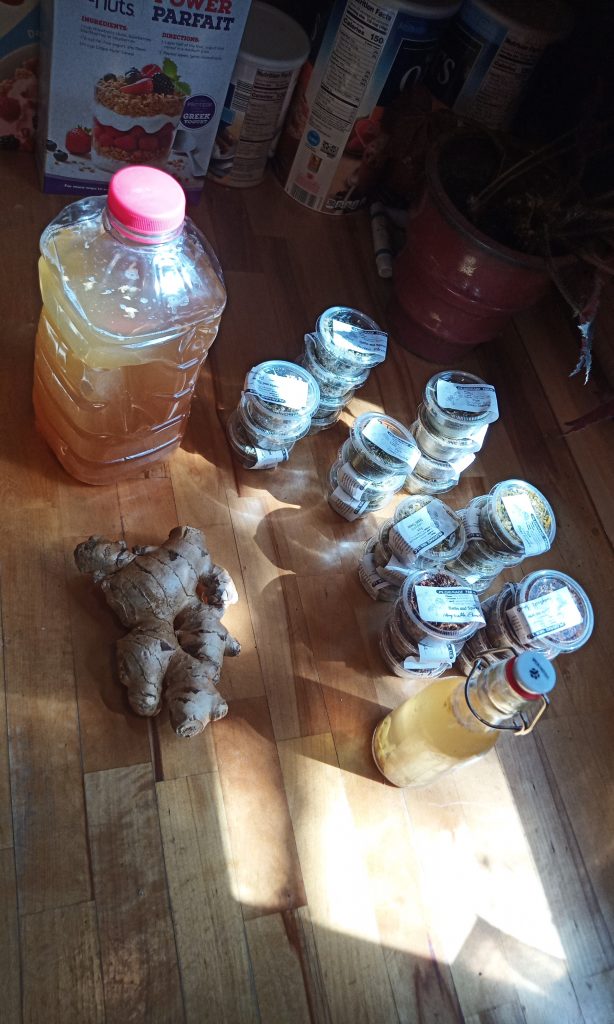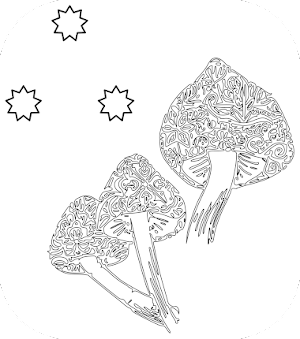Fermenting with home grown ginger bug


Honestly, I dont remember which way mom thought it should be, I think she said that soda is just seltzer water, and pop is the sweet bubbly drink. She married a man when I was like 8 and he said the other one… Either way, what I make at home is really neither. I will lay out my method in 2 stages, a basic recipe for the base, and then seperate herbal recipes to use with the base. Below is the recipe for the base, you can scale it, maintaining the proper ratios to suit your needs. Sugar is actually really important in this, the bug needs food, and you are going to kill off most of the food it would eat in the process, so sugar is needed to affect the fermentation process. If the end result is too sweet for you, then after fermentation is complete you can simply add some cold water when serving to taste.
Part 1, the base recipe
- 1 Gallon Water
- 2 cups sugar
- 2 oz fresh ginger
- 1 cup Ginger Bug (pre made)
Ginger Bug is easy to catch and keep, there are a million blog entries on how to do that so I will ask you to get up to speed with that and have it on hand before proceeding to make this recipe.
Simple, just use filtered sterile water add the sugar and dissolve it completely then boil the mixture. Clean the ginger well, but do not peel it. Now get your Ginger Bug ready, if it is in the fridge, take it out, feed it a little sugar, shake it up good and set in a warm spot to boost the growth while your cooking the mix. When your mixture is boiling good, remove from the heat and grate in the fresh ginger, and add your prepared herbs from the part 2 recipe. Cover and steep the brew until cooled below 90 degrees F.
Once you have on hand basic ingredients, like the Ginger Bug starter, sterile water, sugar, and ginger you can get creative with your own blend of herbs!
Part 2, Herbal blends
Spicy Birch (mushrooms)
- 1 oz Chaga mushroom chunk
- 1 oz Birch Polypore mushroom dried
- 1 oz Appalachian Allspice dried
Wild Flower Herbal
- 1/4 oz Golden Rod flowers dried
- 1/4 oz Honeysuckle flowers dried or wild Rose Hips
- 1/4 oz Yarrow flowers dried
- 1/4 oz Green Sassafras sapling bark dried
Wild Berries
- 1/4 oz dries Fragrant Sumac berries
- 1/4 oz dried Eastern Red Cedar Berries
- 1/4 oz Green Sassafras sapling bark dried
Everything
- All the above ingredients combined ground into a coarse powder, I use about 1/4 cup per gallon
YOU can make your own blend too! The basic requirements are met entirely by the part 1 recipe. I like to use all dried ingredients for the part 2 herb blend, not fresh. It is important to remember a few things when brewing a Ginger Bug soda.
- dont kill the bug… make sure your bug is healthy and hungry, awake and ready to feed. I check the temp of my brew with a cooking thermometer before adding the bug.
- dont kill the herbs, the dried herbs should reach a good pasteurization temperature by adding them after the fresh ginger has been grated into the water just after boiling stops.
- CLEAN and well sealed containers for fermentation are critical, and remember that plastic is ok to use, but can explode under the pressure created in a stout sugar ferment.
Choose your container carefully, be sure that you will fill the container over 90% full. Swing top glass bottles are probably the safest option, I hate having to pack the fresh grated ginger from the bug in thin neck bottles so I like to use half gallon food grade plastic jugs with a wider mouth. You can use plastic, just be sure to burp it if it starts blowing up like a balloon.
Now that your brew is cooled down, your bug is ready and your containers are clean you want to have the prep all done, and hopefully the workspace is recently cleaned and aired out. Setup a mesh strainer on a large clean pitcher and strain off the herbs from your brew, I like to drip dry my herbs and dehydrate for use again later. Time to give the ginger bug one last stir and add it to your brew, complete with the pulp. Stir the mixture and distribute to your bottle or bottles, again be sure to get some pulp in every bottle and fill the bottles about 90% full. When full, go ahead and wipe the tops clean with sterile paper towel and close/seal. Ferment your brew in a warm and relatively dark spot, I like to set mine on a slight incline on top of my fridge, a dishrack works well for this. Check your ferment every day if using a plastic bottle and burp very carefully if needed. If you ever do expand a plastic bottle like a balloon, discard it after your done with that brew, it is NOT safe to use that bottle again.

a few notes after lots of customer feedback.
1, NEVER use chlorinated water, if you have city or municipal water, boil it first, then filter with a high quality water filter
2, The sugar in my “base” recipe is double the min amount to successfully ferment. If you want it “sharper” then just use 1 cup sugar to one gallon water.
Happy brewing!